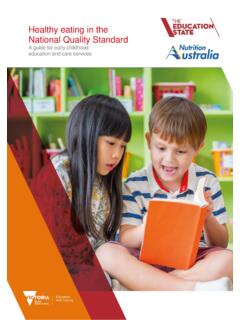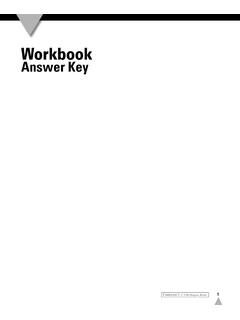Transcription of Barriers to Providing Physical Education and Physical ...
1 Australian Journal of teacher Education Barriers to Providing Physical Education and Physical Activity in victorian State Secondary Schools Kate. A. Jenkinson Amanda. C. Benson RMIT University. Abstract: An on-line questionnaire was completed by 115. Physical Education teachers to establish the Barriers to their implementation of Physical Education in victorian state secondary schools. In addition, the Barriers perceived by teachers to impact on students' participation in school-based Physical Education and Physical activity were examined.
2 The Barriers to the provision of Physical Education were found to be largely institutional, although two-thirds of respondents recognised their own difficulties in engaging students when teaching as potential obstacles to student participation. Students were also perceived to be influenced by their own (45. per cent) and their peers (62 per cent) low levels of interest when choosing to participate. An awareness of these Barriers has implications for Physical Education teaching, curriculum design, teacher training and adolescent participation in the school environment.
3 Introduction With exercise and activity habits commencing early in life and the development of healthy lifestyle behaviours among children and adolescents translating into reduced health risks in adulthood (Dobbins, De Corby, Robeson, Husson, & Tirilis, 2009), quality Education at an early age is paramount. Hence, schools have been identified as key health settings and are being called upon to give greater attention to their Physical Education and Physical activity programs (Naylor &. McKay, 2009; Pate et al., 2006). The combination of the decline in fitness standards of young people, high drop-out rates, and inadequate pathways to accessing Physical activity (Hardman, 2008) and the substantial increase in the prevalence of overweight and obesity among children and adolescents around the world (Eisenmann, 2006)
4 Undoubtedly equates to a growing concernTherefore, it is not only schools that have been identified as having a key role to play, but it is also apparent that Physical educators are becoming more accountable than ever before as their role continues to evolve and they pursue opportunities to facilitate activities that engage students and provide Education on lifestyle choices and healthy behaviours. Schools are learning environments with the capacity to equip students with these attributes; however, it is the quality of the programs in schools that will ensure that young people are given the opportunities to Vol 35, 8, December 2010 1 Australian Journal of teacher Education become physically-educated individuals (Lee, Burgeson, Fulton, & Spain, 2007).
5 The provision of quality Physical Education curriculum can be affected by many factors, some of which can assist or hinder delivery and participation. Literature Institutional and teacher -related Barriers to Physical Education Provision Barriers within schools that restrict teachers Providing Physical Education programs have been classified by Morgan and Hansen (2008) as being either institutional (outside the teachers' control) or teacher -related (arising from the teachers' behaviour). The simplicity of this classification enables it to be applied to both primary and secondary school settings.
6 Previous research has highlighted many institutional Barriers including budget constraints, scarce resources, reductions in time provisions in the curriculum, the absence of professional development, the crowded curriculum itself and the lack of facilities and equipment (Commonwealth of Australia, 1992; Hardman, 2008; Le Masurier & Corbin, 2006; Morgan & Hansen, 2008). Similarly, Dwyer et al. (2003). reported that the lower priority given to Physical Education , the absence of performance measures for Physical Education and activity, and insufficient infrastructure were the three major institutional Barriers identified by generalist elementary teachers in Canada to the provision of a curriculum that was capable of meeting the health and Physical Education guidelines.
7 Most teacher -related Barriers have been reported in primary school studies (Barroso, McCullum-Gomez, Hoelscher, Kelder & Murray, 2005; DeCorby, Halas, Dixon, Wintrup & Janzen, 2005; Dwyer et al., 2003; Morgan & Hansen, 2008). The Barriers described include possessing low levels of confidence or interest in teaching Physical Education , being unable to provide safely planned and structured lessons, having had personal negative experiences in Physical Education and lacking training, knowledge, expertise and qualifications to provide Physical Education (De Corby, Halas, Dixon, Wintrup & Janzen, 2005; Morgan & Bourke, 2005; Xiang, Lowy &.)
8 McBride, 2002). The comprehensive primary school-based findings reflect not only the lack of research across the secondary levels in schools, but could possibly be attributed to both secondary and specialist primary school teachers having dedicated Physical Education units as part of their training. This specialisation should equip teachers with the skills to overcome Barriers more easily and enable them to plan and implement programs accordingly. A summary of institutional and teacher -related Barriers to Physical Education and Physical activity that compares primary and secondary school environments can be found in Figure 1.
9 Vol 35, 8, December 2010 2 Australian Journal of teacher Education Barrier Primary Schools Secondary Schools 1, 7 6. Institutional Access to and lack of facilities Access to and lack of facilities Lack of time 1, 7 Lack of time 2. 7 2. Crowded curriculum Restricted curriculum 1, 7 6. Funding Funding Access to and lack of equipment 1 Ethos of PA for life within the 1 2. Support from other staff school 1, 7 3. Support from administration Socioeconomic status of school Access to professional development 7 Timetabling 6. 1, 5. PE/Sport not priorities in school 1, 7.
10 Large class sizes Budget constraints 7. 5. Insufficient infrastructure 1, 5. Other teaching priorities Quality of facilities 1. 7. Level of professional development School executive attitudes toward PE 1. Insufficient number of PE staff 1, 5. 5. Lack of performance measures for PE. 4. teacher - Lack of training and knowledge Colleagues undervaluing activities 2. related Difficulty of Providing safely planned and structured lessons 4 Ethos of performance/ litism of PE. Gender stereotyping of activities 4 department or school as a whole 2. 4.












